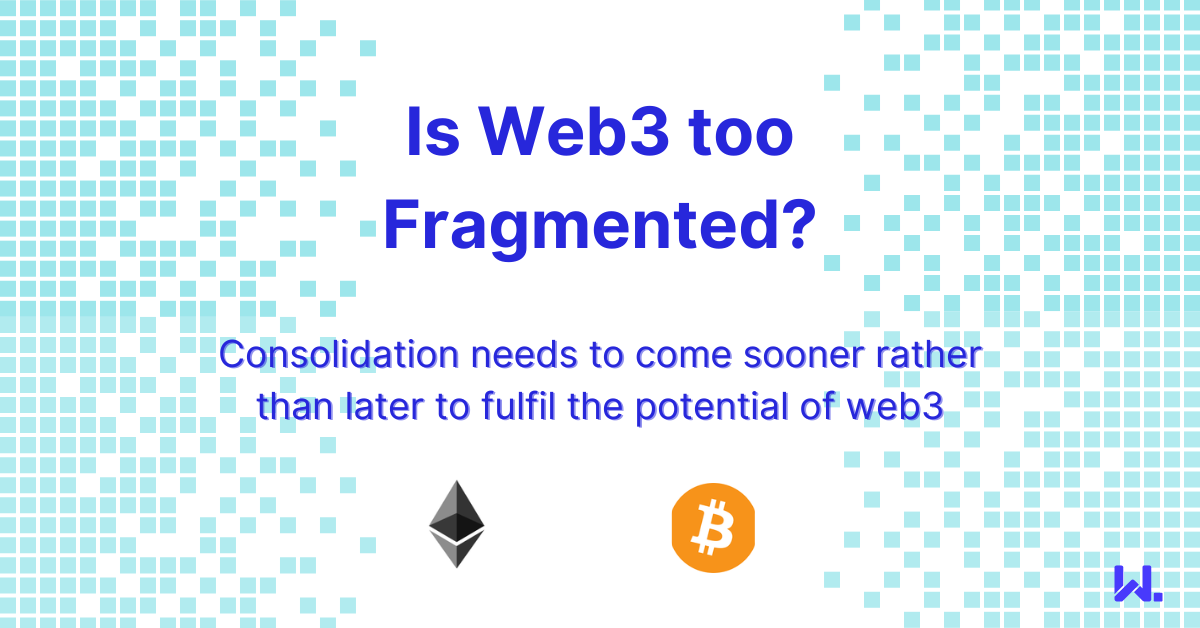How Web2 Centralised the Internet?
The emergence of big tech off the back of Web2, cloud and smartphone technologies resulted in a number of firms thriving. They abstracted away many of the application protocols that facilitated the initial iteration of the Web, and the same playbook could well play out with Web3 if we're not careful.
The web was once abundant with decentralised structures and protocols
The internet and the world wide web were defined by a number of application protocols that were built on top of TCP/IP. These included:
-
HTTP for transmitting documents typically marked up in HTML
-
FTP for file transfer
-
SMTP, IMAP and POP3 for email
-
IRC and XMPP for chat
-
DNS for mapping computer names to IP addresses
-
Others such as NTP, RDP, SNMP, Telnet, SSH, etc
The creation of these open application protocols facilitated an open decentralised internet. In many ways this is not dissimilar to where we are now with Web3, where we have:
-
Standards such as ERC-20 for tokens and ERC-721 for non-fungible tokens
-
Interplanetary File System decentralised storage network
-
Web3 naming services such as Ethereum Name Service
Many of these are tied to Ethereum-compatible networks, but equivalents are being created on other networks. These Web3 application layer protocols, like the equivalents that came with Web1 embrace decentralisation and open source development, enabling other projects and protocols to integrate with and build on top of them. Thus staying true to the collaborative and open models that defined the first iteration of the Web.
The original Web protocols all served important purposes for the different niches in which they operated, and many products and services were built on top of these to streamline the user experience.
However, in the years that followed, a number of these protocols have been abstracted away to the point of irrelevance, and instead, we have HTTP and DNS still widely used, but other protocols such as FTP, IRC/XMPP, and even the email protocols becoming ever less relevant, and instead replaced by web-based equivalents.
This is not something new, back in the mid-90s Hotmail was a website that enabled anyone to claim a free email address. Unfortunately, we've still had to put up with email in the decades since, but we're now at a point where email is becoming less and less relevant, with messaging services such as WhatsApp and Slack being far more superior and convenient services for communication and collaboration.
As popular as chat systems such as IRC were with early internet users, it was not until Slack that they really went mainstream. Slack like many other internet services was initially friendly toward the IRC and XMPP protocols but ultimately ceased to support them in favour of being able to fully control their own ecosystem.
We've also seen it happen with file transfer services, once upon a time FTP was the standard mechanism used to pass files around online, however, its since been superseded by cloud-based platforms such as WeTransfer, Dropbox and Google Files which provide their own technology for moving files around.
The downside is that these services are built using centralised, proprietary technology, which is ultimately bad for the end user, as they have no way in which they can easily migrate to other more competitive services. Even alternative platforms such as Signal have demonstrated signs of going down this route .
These centralized web-based equivalence services for many of the web's application protocols were accelerated in Web2. Alongside cloud technology, we saw the emergence of API-first services. These were dedicated services, usually built using the HTTP protocol that would serve up arbitrary data to their clients.
The changing nature of what typically constituted an end-user client on the internet was a key driver for these changes. The initial web had been focused on serving desktop clients who were typically running a browser such as Netscape, an e-mail client such as Outlook, and perhaps an IRC chat client.
These application protocols were designed with such desktop clients in mind. Smartphones changed this dynamic, and ultimately became the dominant device for internet users globally. Unlike desktops, smartphones also approached the online experience from an app-first perspective, with apps created for the platform-specific Android or iOS platforms.
Whilst smartphone users could get online using browsers, the simplicity of dedicated apps provided a far more streamlined user experience.
Hence most web companies realised the necessity of offering app-first experiences for their users. This shift in focus was bad for the open standards of the web, with what had been the dominant markup language of the web — HTML5 challenged by native smartphone app development frameworks.
This gradual shift away from the core application protocols of the Web by those firms that have captured the most value online such as Google, Facebook, Instagram and Slack demonstrates just how far we have come from the original visions laid out for the web.
There are some differences in Web3 with the governance and incentive mechanisms that it provides via tokens. But the bigger question is if down the line we'll see a similar disregard for the core protocols of Web3.
As we've outlined here, this wasn't just driven by companies abandoning open application protocols for their own proprietary technology. The emergence of smartphones changed what it meant to be a client on the web, and as a result, we saw the usage of the web's open standards narrow and be replaced by closed services built on top of them. This was in part due to the app-centric approach created by smartphone platforms.
So will there be an equivalent disruption for Web3.0? And I don't mean Web3 smartphones such as those announced for Polygon and Solana . I mean something that completely changes the way users interact with Web3 services that onboard the majority of users.
Whilst I don't believe the Web3 smartphone will be that device, perhaps we will see something in the wearables or AR/VR segments that do.
It's not easy to see what such a disruptive force could look like for Web3, however, it does pay to take heed from the lessons of the past to ensure history doesn't simply repeat itself. One hopes that we will see the open protocols and applications of Web3 thrive, as if they remain the dominant platforms in this new era, Web3 will have managed to live up to its expectations.





